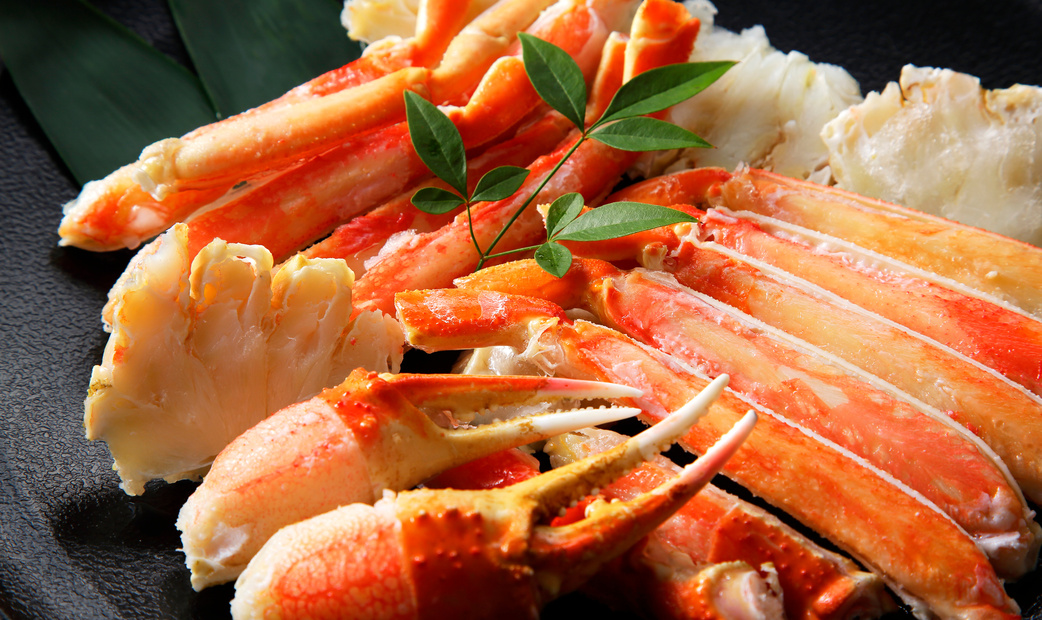
How to Eat Crab in Japan: Recommended Crab Restaurants for Travelers in Tokyo, Osaka, Hyogo, and Hokkaido
The official partner of Michelin, OMAKASE editorial team, has carefully selected 11 restaurants nationwide to recommend to foreign tourists visiting Japan who want to eat crab.
Characteristics of Japanese Crab
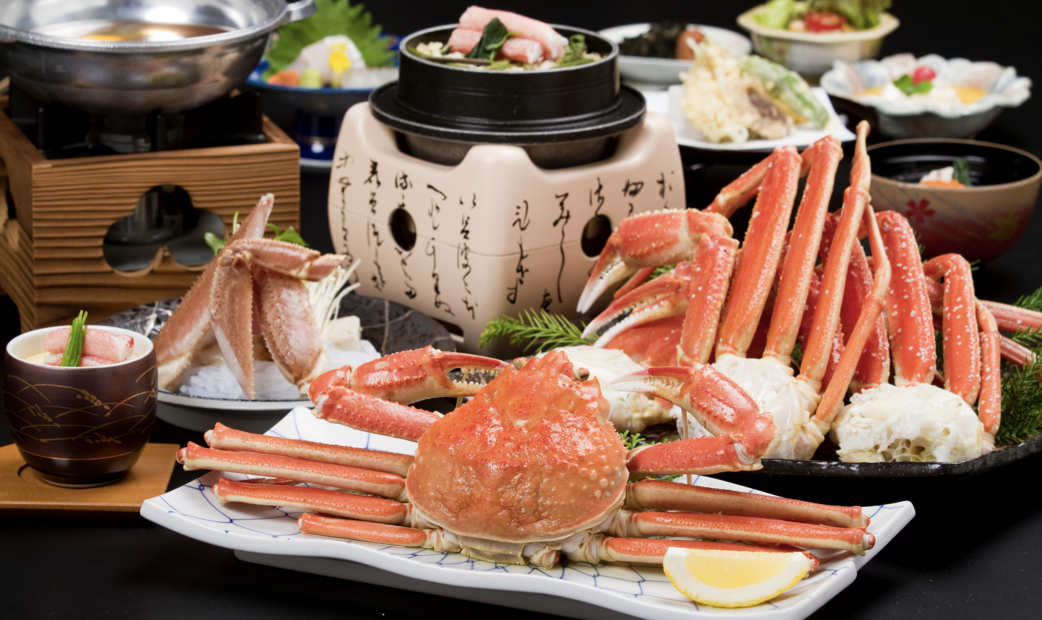
A Popular Luxury Ingredient in Japan
Crab is a beloved ingredient worldwide, including in France, America, and China. In Japan, crab is also enjoyed as a luxury ingredient, often served at celebratory occasions and high-end restaurants.
The "Four Great Crabs of Japan" are the most famous:
- Zuwaigani (Snow crab)
- Tarabagani (a type of Japanese king crab)
- Kegani (Horsehair crab)
- Hanasakigani (a type of Japanese king crab)
Zuwaigani (Snow Crab)
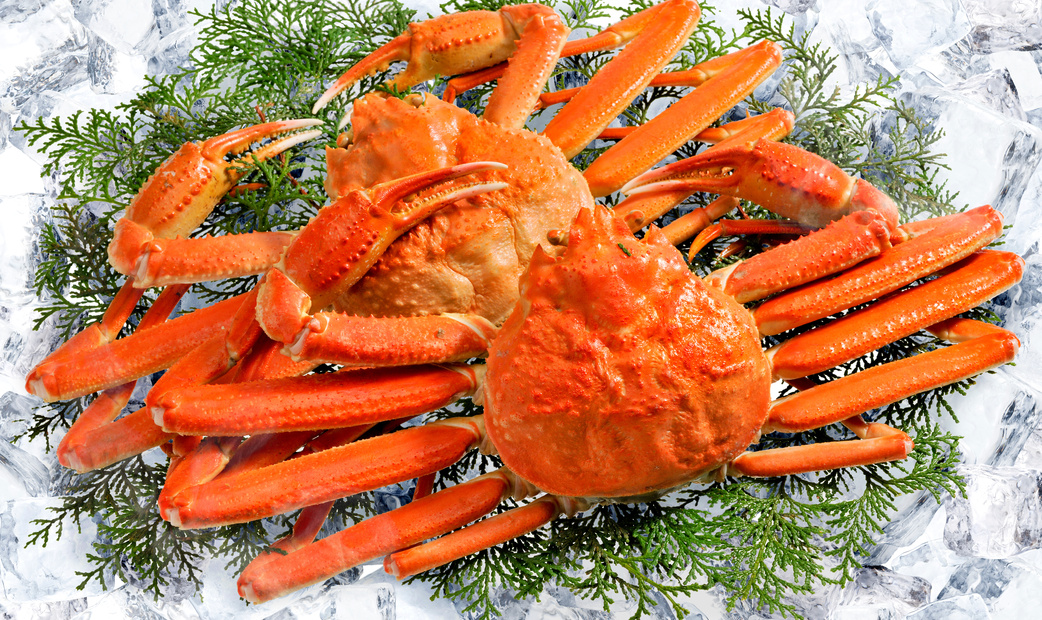
This is the most popular crab in Japan, known for its large size and satisfying meat. Its peak season is from November to March, with major catches in Hokkaido, Tohoku region (northeastern Japan), Shin'etsu (central Japan), and Hokuriku (north-central Japan) areas. Male crabs during this season are characterized by firm, flavorful, tender meat with a sweet taste. The richness of the broth is also a highlight.
Tarabagani (a type of Japanese king crab)
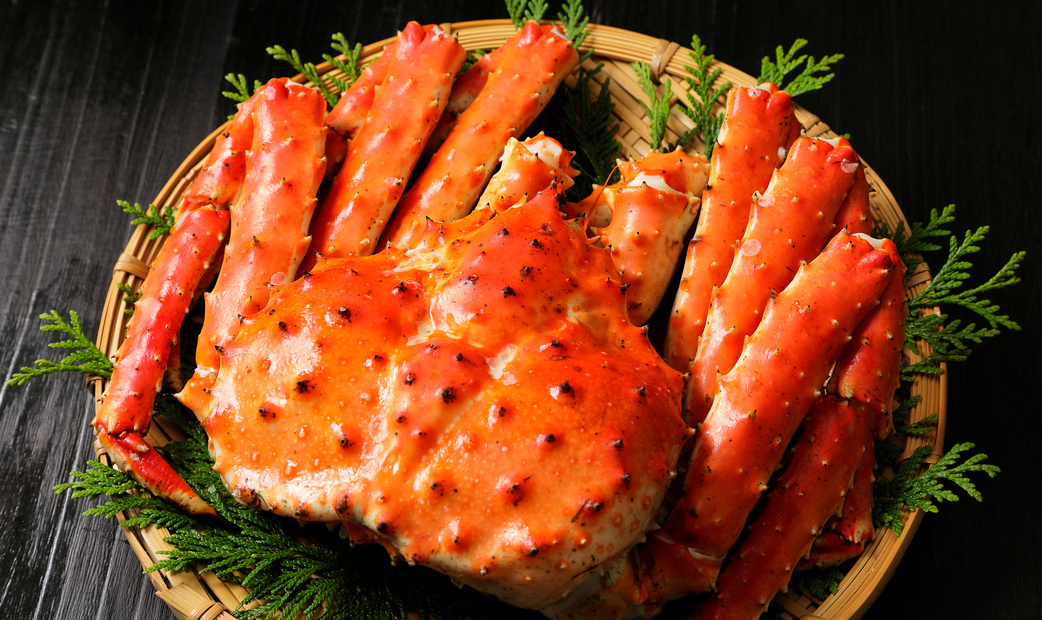
Known for its sweetness, this crab is as popular and high-end as snow crab. It has a rough appearance with spines all over its body and is packed with firm, plump meat. The peak season is from November to March, with catches mainly in Hokkaido and the Sea of Okhotsk.
Kegani (Horsehair Crab)
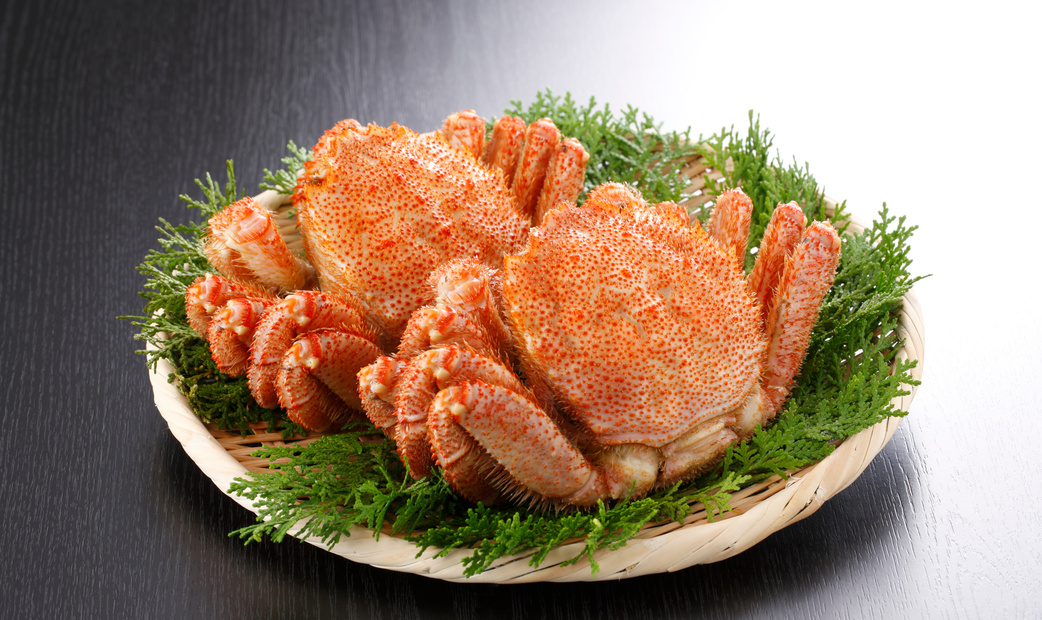
This crab offers sweet, rich crab miso (tomalley). It's covered in short hair all over its shell and legs, with a distinctive appearance of short legs and a hefty weight. Caught year-round in Hokkaido and Iwate, it can be enjoyed throughout the year. The soft meat and sweet, rich crab miso are its main attractions.
Hanasakigani (a type of Japanese king crab)
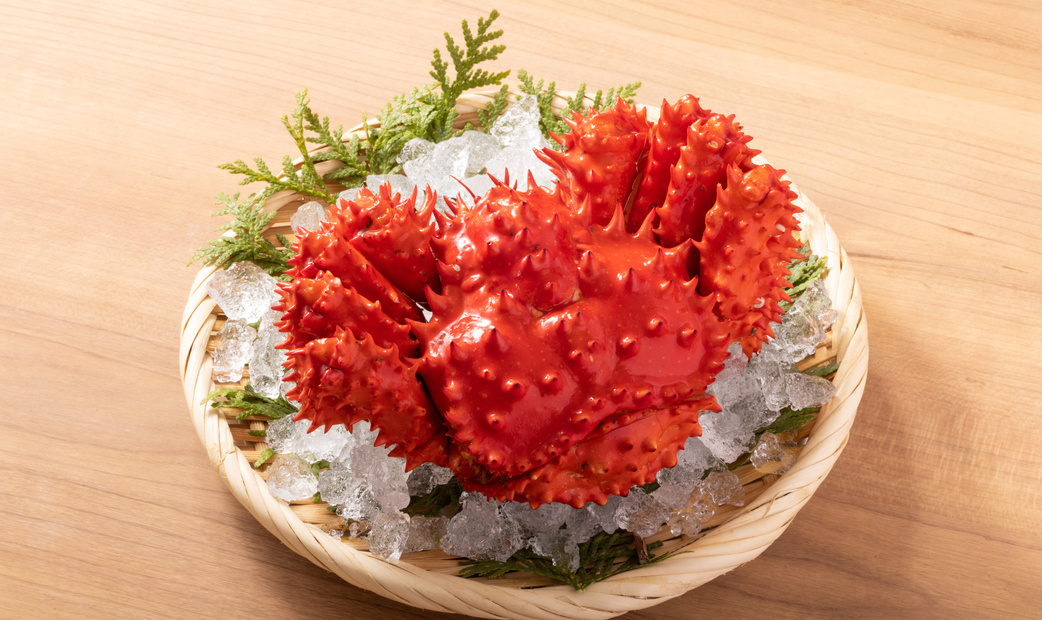
This crab turns a vibrant red color like a flower when heated, hence its name (hana = flower, saki = bloom). It has short legs and large protrusions all over its body, giving it a rough appearance. Mainly caught in Hokkaido, its peak season is from July to September. While it can be eaten raw, it's typically prepared by boiling or grilling. The meat is soft and sweet.
Regional Branded Crabs in Japan
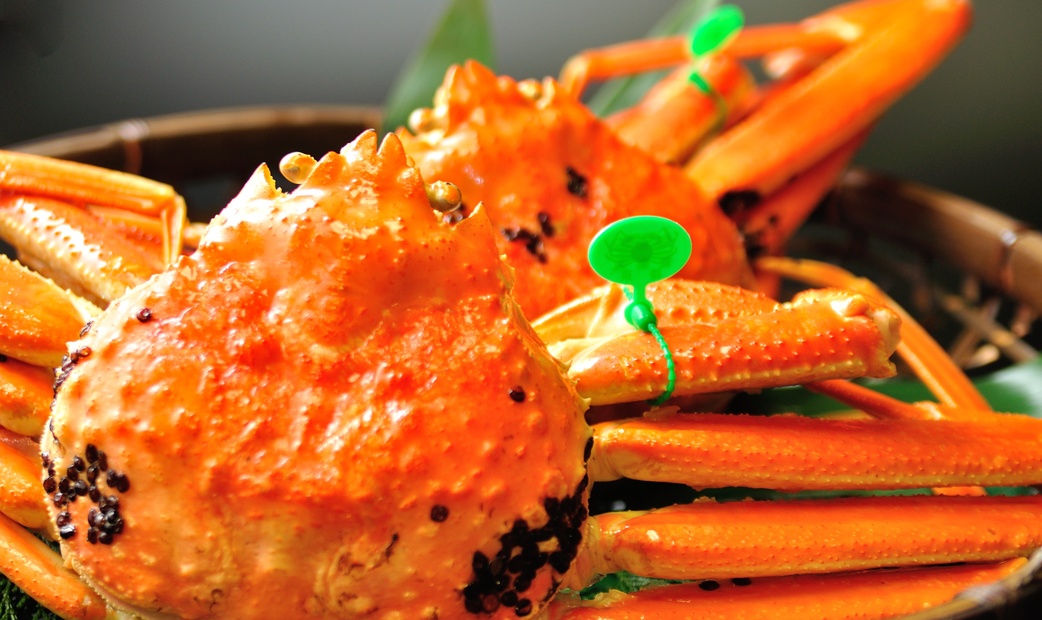
High-end crabs often come with brand names (based on specific regions, fishing ports, size, and meat quality that meet strict criteria). Snow crabs, in particular, are famous for having many branded varieties.
Examples of Branded Crabs:
- Echizen-gani from Fukui Prefecture
- Kano-gani from Ishikawa Prefecture
- Kobako-gani from waters near Toyama Prefecture
- Matsuba-gani from Tottori Prefecture
Snow crab fishing seasons are legally regulated by region. In Hokuriku, the season starts on November 6th and ends between January and March of the following year, depending on the brand. This limited availability adds to their appeal.
Tottori boasts the world's most expensive crab, the "Gokisei," recognized by Guinness World Records. It once sold at auction for 5 million yen (about $45,000) for a single crab.
Branded crabs are particularly expensive, often costing between 10,000 to 30,000 yen (about $90-$270) each.
How to Enjoy Crab in Japan
Eating Raw as Sashimi

Fresh crabs shipped live have firm meat with a strong sweetness and umami. They're typically eaten with Japanese condiments like soy sauce or ponzu (citrus-based sauce).
In restaurants, special crab-specific soy sauce or salt is often provided. This method of eating allows you to savor the crab's natural flavors and is a luxurious way to enjoy extremely fresh crab.
Boiled
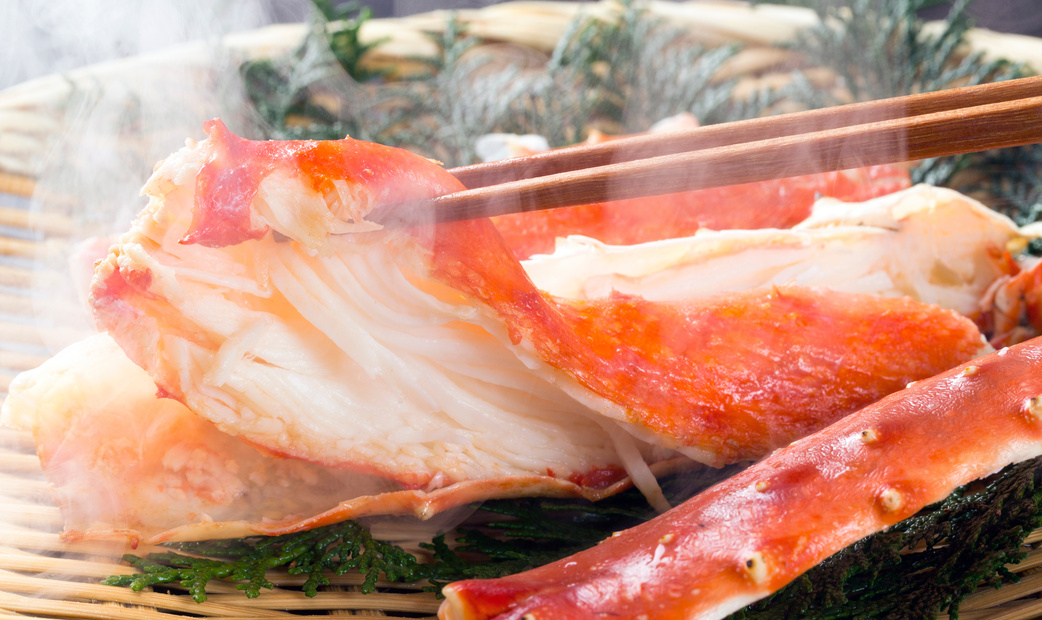
Crabs are often sold pre-boiled, and at home, it's common to thaw and then boil them before eating. In restaurants, boiled crab is typically served simply with salt or soy sauce, similar to sashimi. Some crab specialty restaurants also offer shabu-shabu (hot pot style), where the crab is partially boiled at the table.
Steamed
.jpeg)
Steamed crab in restaurants is often enjoyed in its pure form, similar to boiled crab. Steaming removes excess moisture, enhancing the crab's natural sweetness and creating a firm texture.
Grilled
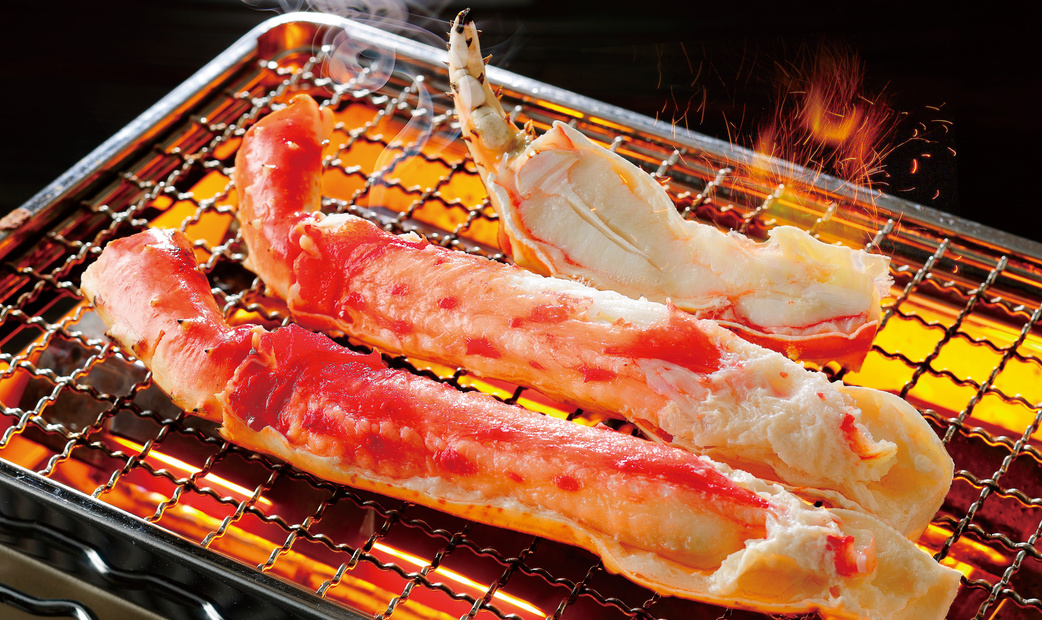
Grilling large crabs like king crab or snow crab is also popular. In restaurants, grilled crab is often served with lemon, sudachi (a citrus fruit), soy sauce, or salt on the side.
Eating Crab Miso (Tomalley)
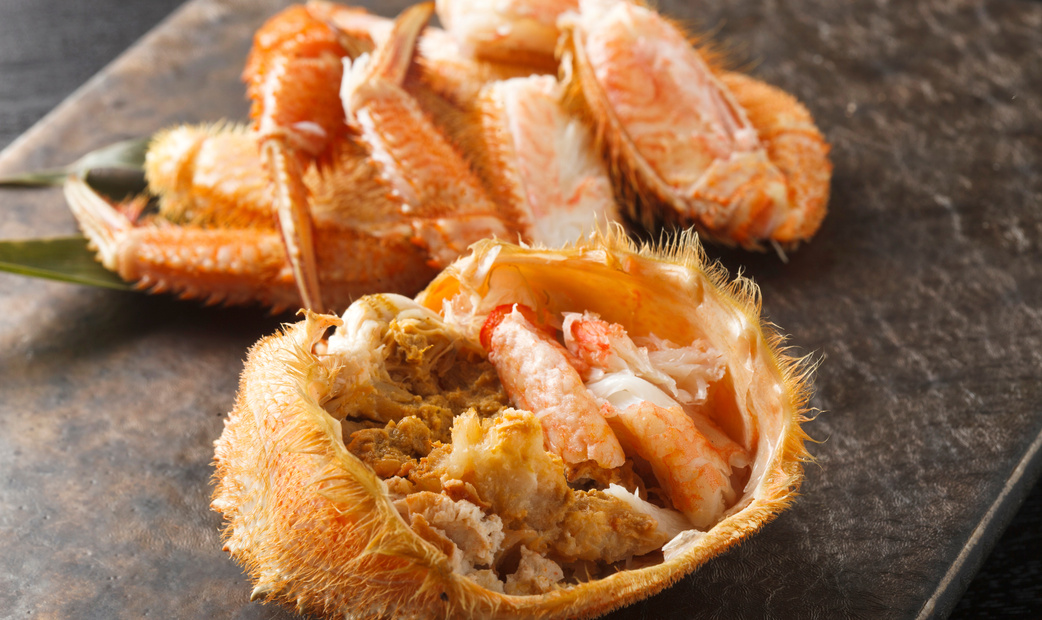
Crab miso, which is the crab's internal organs (similar to liver in meat), is considered a delicacy. The best types for crab miso are snow crab, red snow crab, horsehair crab, and blue crab. It lacks the strong seafood smell and offers a rich crab flavor.
In restaurants, crab miso is typically served by opening the boiled crab's shell and scooping it out with a spoon. The simple preparation allows you to fully appreciate the rich taste and aroma unique to crab miso.
Crab in Fine Dining
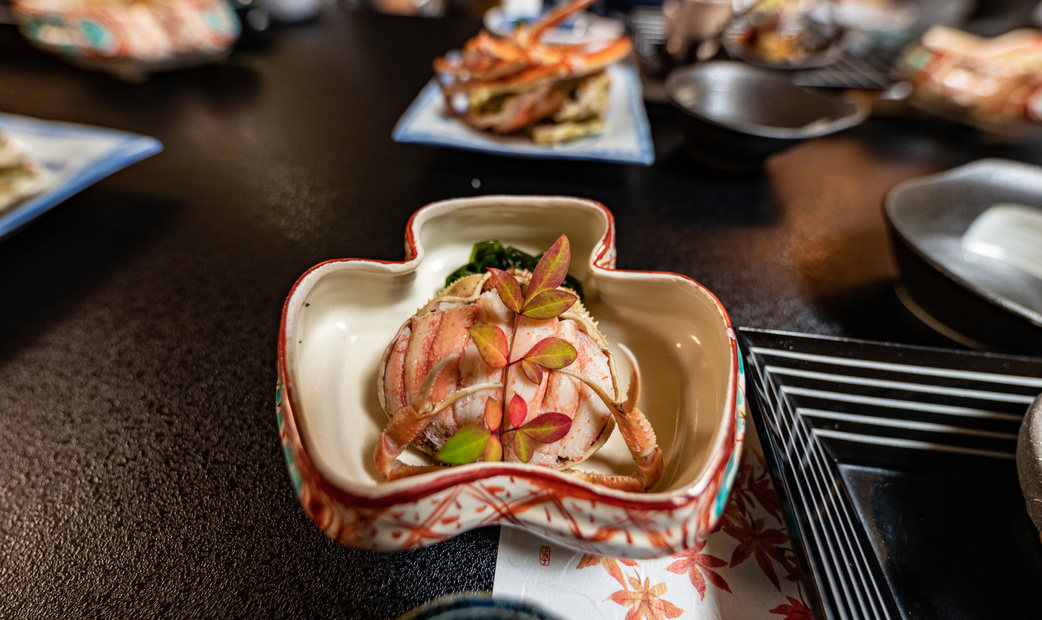
In Japanese fine dining, there's a wide range of crab experiences. Some specialty restaurants offer full-course crab kaiseki (traditional multi-course Japanese dinner) meals, while many traditional kaiseki establishments feature crab as a special seasonal ingredient in their autumn and winter omakase courses (chef's choice menu) . Since autumn is also when matsutake (prized Japanese pine mushrooms) are in season, some restaurants offer the luxury of enjoying both of these highly-valued Japanese seasonal delicacies together.
Additionally, tempura (battered and deep-fried seafood or vegetables) restaurants and sushi bars may include crab tempura or crab dishes as part of their omakase menus.
This article introduces popular Michelin-starred fine dining establishments where you can enjoy crab as part of their omakase courses. While focusing on Tokyo, we'll also cover notable restaurants in Kyoto, Hokkaido, Kobe, Osaka, and Ishikawa (regions known for their culinary traditions).
Caution: The inclusion of crab in the course varies depending on the time of year.
10 Fine Dining Restaurants to Enjoy Japanese Crab
I'll introduce you to restaurants that include crab in their omakase courses (chef's choice menu), as well as crab specialty restaurants.
In Japanese omakase courses(chef's chocie menu), the menu can change depending on ingredient availability. If you definitely want to eat crab, it's better to mention this request in the notes section when making a reservation.
1. Ginza Toyoda (銀座 とよだ) / Japanese / Tokyo / Ginza
A Michelin-starred Japanese restaurant, formerly holding two stars. The chef personally selects fresh ingredients from Tsukiji market every morning. Enjoy seasonal crab and other ingredients in both lunch and dinner courses. The serene sukiya-style (traditional Japanese architectural style) interior with pale wood creates a relaxing atmosphere for savoring seasonal Japanese cuisine.
- Operation hours
- Lunch: 12:00 PM - 3:00 PM (Last entry time is 1:00 PM)
Dinner: 6:00 PM - 10:00 PM (Last entry time is 7:00 PM) - Regular holiday
- Sundays, Public Holidays, Irregular Holidays
- Price range
-
Lunch: USD 242.99 - USD 242.99
Dinner: USD 242.99 - USD 242.99 - Address
- 2nd floor, Raviare Ginza Building, 7-5-4,Ginza, Chuo-ku, Tokyo
- Nearest station
- Ginza Station
- Directions from station
- 4 minutes walk from Ginza Station
- Payment methods
- Cash, Credit card (JCB/VISA/Master/AMEX/Diners/銀聯)
- Seats
- 23 Seats (Table: 8 Seats, Semi-private room: 6 Seats, Counter: 9 Seats)
- Awards
-
MichelinAwards
-
Special dinner4.3Posted on :08/11/2024
-
Angelo - Italy5.0Posted on :04/02/2024
-
W.Z5.0Posted on :02/28/2024
2. Shunkeian Arakaki (旬恵庵 あら垣) / Tempura / Tokyo / Tsukiji
A Michelin-starred Japanese restaurant featuring Okinawan ingredients like goya (bitter melon) and island carrots, reflecting the chef's heritage. Focusing on locally sourced seafood from Tokyo Bay, their tempura includes a variety of items like crab and tiger prawns. The intimate space is decorated with Okinawan touches like the sanshin (Okinawan three-stringed instrument) and awamori (Okinawan distilled spirit) pottery, adding to its unique charm.
- Operation hours
- Lunch: 12:00 PM - 3:00 PM
Dinner: 6:00 PM - - Regular holiday
- Mondays,Sundays
- Price range
- Dinner: USD 137.70 - USD 161.99
- Address
- 1F-B, VORT Shintomi-cho, 3-5-10, Minato, Chuo-ku, Tokyo
- Nearest station
- Shintomi-cho Station
- Directions from station
- 5 minutes walk from Shintomi-cho Station
- Payment methods
- Credit card available
- Seats
- 8 Seats
- Awards
-
MichelinAwards
-
Christina5.0Posted on :10/01/2024
-
Yi Huang4.2Posted on :04/23/2024
-
Jonathan Harmon4.7Posted on :03/01/2024
3. Akiyama (あき山) / Japanese / Tokyo / Shirokane
A consistently Michelin-starred Japanese restaurant offering omakase courses (chef's choice menu) with fresh ingredients from Tsukiji. Enjoy seasonal sashimi, vegetables, hand-made soba, and freshly cooked rice. From November 1st to March 31st, they offer special crab courses for lunch and dinner. The selection of seasonal sake is sure to please drink enthusiasts. The counter-only seating provides an intimate dining experience.
- Operation hours
- Lunch:12:00 PM - 2:00 PM
Dinner:6:00 PM - 11:00 PM - Regular holiday
- Irregular Holidays
- Price range
-
Lunch: USD 157.46 - USD 218.69
Dinner: USD 218.69 - USD 349.91 - Address
- 101 Sakura Shirokane, 6-5-3,Shirokane, Minato-ku, Tokyo
- Nearest station
- Shirokanetakanawa Station,Ebisu Station
- Directions from station
- 10 minutes walk from Shirokanetakanawa Station
10 minutes walk from Ebisu Station - Payment methods
- Credit card available
- Seats
- Counter 8 Seats
- Awards
-
MichelinAwards
-
Amanda Lu5.0Posted on :01/07/2024
4. Kasumicho Yamagami (霞町 やまがみ) / Japanese / Tokyo / Azabu
This Michelin-starred hidden gem specializes in subtle flavors that highlight seasonal ingredients. Their crab courses feature grilled crab, Taizagani (high-quality crab from Kyoto), and Matsubagani (premium winter crab). Diners can choose from several options for grilled dishes and clay pot rice, even in the omakase menu. The understated decor and service reflect the depth of Japanese culture.
- Operation hours
- 6:00 PM - 11:00 PM
- Regular holiday
- Mondays
- Price range
- Dinner: USD 356.39 - USD 712.78
- Address
- Yawata Building 3F, 4-2-13 Nishi-Azabu, Minato-ku, Tokyo
- Nearest station
- Hiroo Station
- Directions from station
- 8 minutes walk from Hiroo Station
- Payment methods
- Cash, Credit card available
- Seats
- 20 Seats
- Awards
-
MichelinAwards
-
Zainub5.0Posted on :03/22/2024
-
Aakash Patel5.0Posted on :02/10/2024
-
Molala4.8Posted on :12/10/2023
5. Nihonryori Takahashi (日本料理 たかはし) / Japanese / Tokyo / Koto
Selected for the Michelin Guide in 2023 and 2024, this Japanese restaurant offers innovative cuisine that incorporates meat dishes. The chef, who once worked in Singapore, personally selects seasonal ingredients from the market. Open only for dinner, it offers omakase courses in a cozy 10-seat counter setting.
- Operation hours
- 6:00 PM - 11:00 PM (Last Order: 8:30 PM)
- Regular holiday
- Sundays, Public Holidays
- Price range
- Dinner: USD 178.19 - USD 356.39
- Address
- 1F FIRST WOOD Bldg. ,1-7-6, Morishita, Koto-ku, Tokyo
- Nearest station
- Morishita Station
- Directions from station
- 1 minute walk from Morishita Station
- Payment methods
- Cash, Credit card
- Seats
- 10 Seats
- Awards
-
Michelin
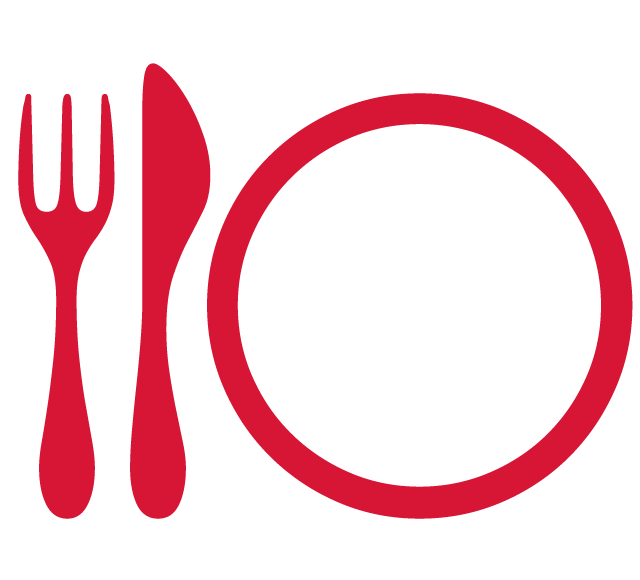
6. Kashiwadeno - Tsukasa Suikouan (膳司 水光庵) / Japanese / Tokyo / Azabu
This restaurant in a quiet residential area of Higashi-Azabu emphasizes Japanese cultural traditions like tea ceremony, calligraphy, and flower arrangement. Seasonal ingredients are presented in elegant kaiseki (traditional multi-course) style, with special courses featuring delicacies like matsutake mushrooms and crab. They offer unique pairings of Japanese cuisine with sake and Burgundy wines.
- Operation hours
- Part 1:16:30 - 19:30
Part 2:20:00 - 23:00 - Regular holiday
- Sundays, Mondays
- Price range
- Dinner: USD 353.44 - USD 353.44
- Address
- 1F Filpark Higashi-Azabu, 2-14-8 Higashi-Azabu, Minato-ku, Tokyo
- Nearest station
- Azabu-juban Station, Akabanebashi Station
- Directions from station
- 5 minutes walk from Azabu-juban Station
5 minutes walk from Akabanebashi Station - Payment methods
- Cash, Credit card, and some electronic money
- Seats
- 14 Seats
7. Higashichaya Nakamura (東茶屋 なかむら) / Japanese / Osaka / Tenjinbashi
A Michelin-starred restaurant (formerly two-starred) run by a Kanazawa-born chef, sourcing 90% of its fish from Ishikawa Prefecture. Specialties include Kano crab (premium crab from Ishikawa) from Ishikawa, along with other fresh seafood prepared simply to highlight natural flavors. The restaurant's decor evokes the atmosphere of Hokuriku region, featuring Wajima lacquerware and Kutani pottery (both traditional crafts from Ishikawa).
- Operation hours
- 18:00-、20:45-
- Regular holiday
- Wednesdays, Irregular Holidays
- Price range
- Dinner: USD 250.36 - USD 363.75
- Address
- 1-25-8,Higashi, Honjo, Kita-ku, Oaka-shi, Osaka
- Nearest station
- Tenjinbashisuji-Rokuchome Station
- Directions from station
- 8 minutes walk from Tenjinbashisuji-Rokuchome Station
- Payment methods
- Credit card available
- Seats
- 15 Seats
- Awards
-
MichelinAwards
8. Tempura Sakurabito (天ぷら 桜人) / Tempura / Hyogo
Opened in August 2022, this reservation-only tempura restaurant in Ashiya City, Hyogo Prefecture, specializes in light, crispy tempura that's easy on the stomach. They use some organic ingredients for a healthier dining experience. Crab tempura is available as a seasonal winter specialty. The restaurant offers a variety of tempura items year-round and provides ponzu sauce (citrus-based sauce) as an alternative to traditional tempura dipping sauce.
- Operation hours
- 18:00 -
- Regular holiday
- Wednesdays
- Price range
- Dinner: USD 184.08 - USD 184.08
- Address
- Albele Court 2F, 10-9, Chayamachi , Ashiya-shi, Hyogo
- Nearest station
- Ashiya Station
- Directions from station
- 10 minutes walk from Ashiya Station
- Payment methods
- Cash, Credit card available
- Seats
- 8 Seats
9. Ryoriya So (料理屋 素) / Japanese / Hokkaido
A Japanese restaurant in Sapporo, Hokkaido, known for its fresh seafood dishes. The Hokkaido-born chef, trained in Kyoto and Kagawa, focuses on using the best market-fresh ingredients daily. In winter, they offer a full-course crab menu featuring exquisite hairy crab served as sashimi and lightly cooked with crab miso (fermented crab innards). They also have a branch in Niseko, both maintaining consistent quality under the owner-chef's supervision.
- Operation hours
- Dinner:17:00 - 21:00 (Last entry: 19:00)
- Regular holiday
- Saturdays, Sundays, Holidays(The restaurant will be closed from 12/1 to 3/31)
- Price range
- Dinner: USD 178.19 - USD 356.39
- Address
- 28-2-18,Nishi, 1-jo, Chuo-ku, Sapporo-shi, Hokkaido
- Nearest station
- Maruyamakoen Satation, Nishi28chome Station
- Directions from station
- 4 minutes walk from Maruyamakoen Satation
6 minutes walk from Nishi28chome Station - Payment methods
- Credit card available
- Seats
- 10 Seats
10. Kounryusui NISEKO (行雲流水NISEKO) / Sushi / Hokkaido
A popular sushi restaurant in Niseko, Hokkaido, attracting both domestic and international guests. This winter-only sister restaurant of "Ryoriya So" offers sushi courses, crab-only courses, and combined sushi and crab set menus. The modern interior combines natural wood with black accents, creating a sophisticated atmosphere. With counter seating for up to 6 and a table for 4, it provides an intimate dining experience. A large in-house tank displays seasonal crabs and shellfish.
- Operation hours
- Part 1:17:00~
Part 2:19:30~ - Regular holiday
- Irregular Holidays
- Price range
- Dinner: USD 267.29 - USD 356.39
- Address
- 1-13-5, Nishi, Kita1, Kutchan Cho, Abuta District, Hokkaido
- Nearest station
- Kutchan Station
- Directions from station
- 7 minutes walk from Kutchan Station
- Payment methods
- Credit card available
- Seats
- 10 Seats
11. Ubuka (うぶか) / Tokyo / Yotsuya
A Michelin-starred restaurant specializing in crustaceans (shrimp and crab). The menu features luxurious dishes showcasing these ingredients, such as a soup combining Shogoin daikon (a type of giant white radish) and snow crab. With its diverse preparation styles, this restaurant is ideal for crustacean enthusiasts. The drink menu focuses on white wines and sake that pair well with shellfish dishes, allowing guests to discover their perfect food and drink combination.
- Operation hours
- 5:30 p.m. -
- Regular holiday
- Sundays, holidays
- Price range
- JPY 22,000 - JPY 27,000
- Address
- 2-14 Arakicho,IS II Building 1st Floor, Shinjuku-ku, Tokyo
- Nearest station
- Yotsuya-sanchome Station
- Payment methods
- Cash, cards
- Seats
- 14 seats


